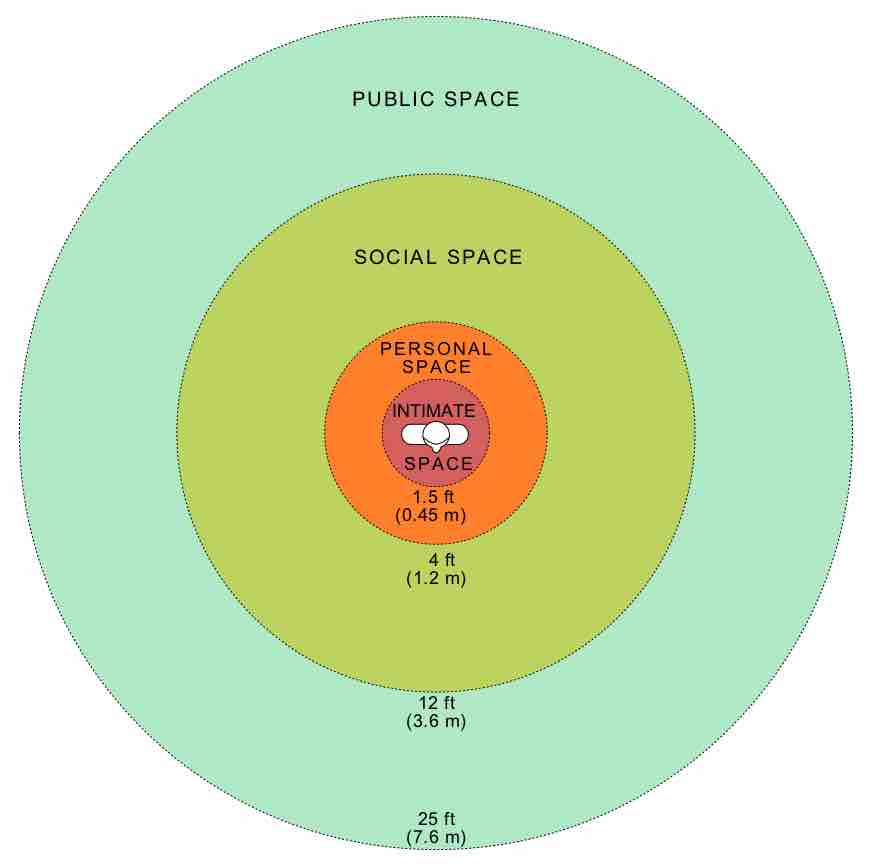Use of Space and Distance Zones
Proxemics is the study of how people use and perceive the physical space around them. The space between the sender and the receiver of a message influences the way the message is interpreted. In addition, the perception and use of space varies significantly across cultures and different settings within cultures.
Body spacing and posture, according to Edward T. Hall, are unintentional reactions to sensory fluctuations or shifts, such as subtle changes in the sound and pitch of a person's voice. Social distance between people is reliably correlated with physical distance, as are intimate and personal distance, according to the delineations below. Hall did not mean for these measurements to be strict guidelines that translate precisely to human behavior, but rather a system for gauging the effect of distance on communication and how the effect varies between cultures and other environmental factors.
According to Hall in his book, The Hidden Dimension, space in nonverbal communication may be divided into four main categories: intimate, social, personal, and public space .

Diagram of Personal Space
Distances for different communication using Edward T. Hall categories.
Intimate distance for embracing, touching, or whispering.
- Close phase – less than 6 inches (15 cm)
- Far phase – 6 to 18 inches (15 to 46 cm)
Personal distance for interactions among good friends or family members.
- Close phase – 1.5 to 2.5 feet (46 to 76 cm)
- Far phase – 2.5 to 4 feet (76 to 120 cm)
Social distance for interactions among acquaintances.
- Close phase – 4 to 7 feet (1.2 to 2.1 m)
- Far phase – 7 to 12 feet (2.1 to 3.7 m)
Public distance used for public speaking.
- Close phase – 12 to 25 feet (3.7 to 7.6 m)
- Far phase – 25 feet (7.6 m) or more.
Territoriality: Claiming Your Space
The concept of terrritoriality parallels proxemics and helps to explain how you lay claim to the space around you. There are four territories associated with different distance:
- Primary territory: This refers to an area that is associated with someone who has exclusive use of it. An example is a house that others cannot enter without the owner's permission.
- Secondary territory: Unlike primary territory, there is no "right" to occupancy of secondary territory, but people may still feel some degree of ownership of such space as they develop the custom of occupying it. For example, someone may sit in the same seat in church every week and feel irritated if someone else sits there.
- Public territory: this refers to an area that is available to all, but only for a set period, such as a parking space or a seat in a library. Although people have only a limited claim over that space, they often extend that claim. For example, it was found that people take longer to leave a parking space when someone is waiting to take that space.
- Interaction territory: this is space held by others when they are interacting. For example, when a group is talking to each other on a footpath, others will walk around the group rather than disturb their interaction territory.
Generally, public speaking will occur in the far phase of the social distance and primarily in the public distance. The audience may be in a secondary space which they normally occupy or in a public territory which is set aside for the particular event.
Tips for Speaker
- At the most basic level, the speaker who is using public space needs to make sure that the voice is loud enough to be heard and that all members of the audience can see the speaker, gestures, and any supporting visual materials.
- But, going beyond the basic considerations, the speaker may want to consider strategies for making the public space more social and personal to achieve conversational goals. If appropriate, the speaker may move off the platform and into the very front of the audience or move among the audience while speaking.
- The speaker should determine if the seating is fixed in one direction or movable in order to plan any activity within the audience such as informal or small group activities.
Remember, in the public territory of the speaking event, the speaker only has the space for a limited period of time and needs to use that time efficiently.